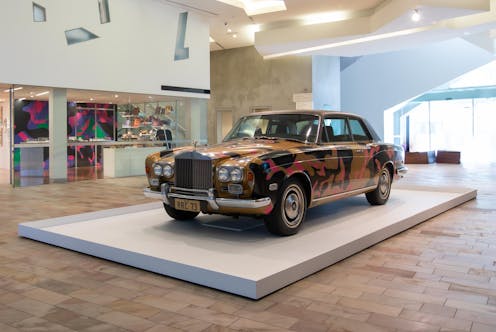NGV’s Reko Rennie retrospective asks whether he should be considered Australia’s Keith Haring
- Written by Sasha Grishin, Adjunct Professor of Art History, Australian National University

Is Reko Rennie Australia’s equivalent of Keith Haring? Both Rennie, a Melbourne-based Aboriginal artist who celebrates the heritage the Kamilaroi people of northern New South Wales, and Haring, the American pop art great, emerged out of an urban graffiti culture.
Both create a widely recognisable visual language that has a striking vitality, sense of authenticity and a pulsating vibrancy. Both are deeply autobiographical artists who created a visual code through which to share their personal histories.
Rennie is an interdisciplinary artist who seamlessly moves between video, printmaking, sculpture, painting and neon art. With more than a hundred works on display, drawn from the artist’s two-decade-long career, this is the first significant retrospective of his art.
Rennie possesses the gift of creating memorable images that are simultaneously puzzling, intriguing and entertaining. On entering the gallery, you encounter a 1973 Rolls-Royce Corniche decorated with the strange camouflage colours that reoccur throughout Rennie’s art. The physical car is accompanied by a three-channel video work with a Nick Cave and the Bad Seeds soundtrack.
Beginnings
Although born in Footscray in Melbourne, the artist’s grandmother Julia, who belonged to the Stolen Generation in the 1920s and was enslaved on a pastoral station, raised him and imparted to him his Kamilaroi heritage. In his youth, Rennie saw a photograph of a pastoralist and his wife dressed up for Sunday church and seated in their luxury Rolls-Royce car. At the time, he reflected on the poverty his grandmother would have experienced while working on a pastoral station.
The markings he made on the car, that are layered with a traditional diamond pattern of the Kamilaroi people, claim ownership over the vehicle. Inside it is a photograph of his grandmother. In the video, with a setting sun as a backdrop, Rennie drives the car down dirt tracks to his home country and, in something resembling burnouts, he makes traditional sand engravings with the tyres of the car. The work is poignant, evocative and becomes quickly embedded in your memory.
The piece references an earlier one, with a pink 1973 Holden Monaro. In that video, the car performs a series of burnouts and doughnuts, the traditional initiation ceremony with Westie drag-racing culture of suburbia into which the artist was born. This is in contrast with the initiation practices and traditional sand engravings of the Kamilaroi people. The video is accompanied with an operatic score from Yorta Yorta woman, composer and soprano, Deborah Cheetham, performed with the Melbourne Symphony Orchestra. Again, the video becomes a haunting and somewhat surreal experience.
Street spaces
Rennie is an artist who looks best when he operates in a public environment.
His early street art, accompanied by break dancing and hip hop, thrives in the accidental lighting of urban spaces. He loves the way street art can ambush the viewer and employ strategies that catch and hold the gaze of the casual passerby. Keith Haring and Howard Arkley were two of the artists who pointed a way for Rennie to move from the street and onto the gallery wall. Although they may have suggested some of the formal strategies, Aboriginal culture provided the content that would consummate the work and give it a narrative.
When in 2020 there was a commemoration of the 250th anniversary of Lieutenant James Cook’s first landfall at Botany Bay and the HMB Endeavour’s charting of the East Coast of Australia, the Carriageworks in Sydney commissioned Rennie to make a piece for the occasion.
His monumental text work is made up of LED neon lettering held up in an aluminium armature. It measures over two-and-a-half metres in height and almost 19 metres in length. The simple message, one anchored in a tradition of street art, reads: “REMEMBER ME”. Cook’s landing marked the beginning of a process of invasion and dispossession, Rennie’s text affirms an opposition to the invasion and stresses that First Nations people survived. Sovereignty was never ceded.
This message has been at the core of much of Rennie’s art, for instance, in the two neon pieces, OA Warrior I (pink) and OA Warrior I (blue), both from 2020. They are based on an 1800s photograph of a defiant Kamilaroi warrior with his raised club. The message is that the OA (Original Aboriginal) will never cede sovereignty.
In a much earlier piece from 2016, that has always been one of my favourites in Rennie’s art, a ten-metre-long banner bears the inscription, “I was always here”. It is made of hand-pressed metallic foil on satin where he employs the geometric diamond patterning of the Kamilaroi people as a background to the words.
The work commemorates all of the Frontier Wars, massacres and oppression suffered by First Nation peoples in this country and in many other countries in a powerful way.
‘We’re not a monoculture.’ Artist Reno Rennie introduces his works.Impressive and consistent
Rennie, who turns 50 this year, exhibited at the 56th Venice Biennale in 2015 and with the 2016 XIII Bienale de Cuenca in Ecuador and has held numerous exhibitions across Australia, Asia, the United States and Europe.
His star is in the ascendancy and he is widely regarded as one of Australia’s most distinctive and versatile artists, who is attracting international acclaim.
Beautifully curated by Myles Russel-Cook as his final show at the NGV before he takes up the directorship of ACCA, Rekospective is impressive in scope, consistent in content but not repetitive.
While Keith Haring died at the age of 31, I feel Reko Rennie will be viewed, in retrospect, as an artist at least as significant as Haring and one of growing importance in Australian art.
REKOSPECTIVE: The Art of Reko Rennie is at The Ian Potter Centre: NGV Australia until 27 January 2025. Free admission.
Authors: Sasha Grishin, Adjunct Professor of Art History, Australian National University





